(This article is summarized from Chapters 2 and 4 of The Harmonium Handbook, available from Crystal Clarity Publishers.)
The harmonium is a simple, hand-pumped reed organ. Pumping the external bellows inflates the internal bellows, creating air pressure within the instrument. Under the keyboard are two chambers in which are mounted two rows of brass reeds, one octave apart, with a pair of reeds beneath each key.
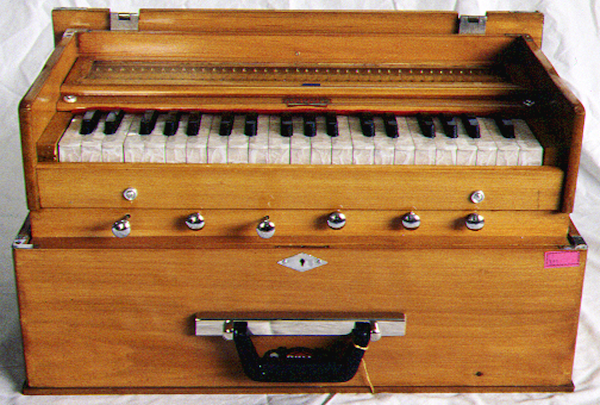
The air stop knobs on the front of the instrument control the air flow into each of those chambers. Pressing a key opens holes above the reeds that allow air to flow from the internal bellows past the reeds, causing them to vibrate and produce sound. So long as you maintain the air pressure by pumping the external bellows, you can sustain the sound indefinitely.
Know, however, that as soon as you let up on a key, the sound stops immediately. For this reason, harmonium players learn to keep at least one key down most of the time so as to maintain a relatively smooth, steady sound throughout the chant.
The bellows
The bellows come in two varieties, depending on the model of the harmonium. Top-fold bellows pivot at the bottom and are latched at the top.
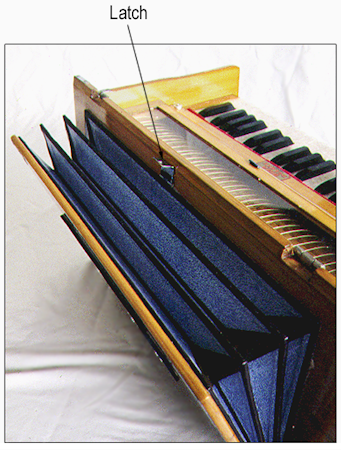
Side-fold bellows latch on either side and pivot on the other.
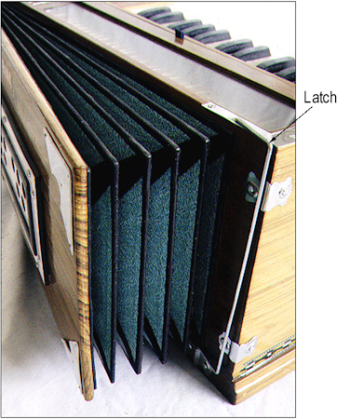
Either way, the bellows usually have some kind of spring that pushes them open on their own, making it easier for you to open them up with each pumping action. On the back of the bellows are some air holes behind which is a simple leather flap that acts as a one-way valve. This valve, which you can see opening and closing when someone is playing the instrument, keeps the air pressure inside while the external bellows moves outward.
Effective pumping
An effective way to pump the external bellows is to mimic how you might breathe when singing: your take a quick inhalation and then exhale while singing notes over a longer period of time. In the case of the harmonium, the “inhalation” is when the external bellows expand outwards, and the “exhalation” is when you draw them back in.
Accordingly, to let the bellows inhale, relax your hand and allow the bellows to expand naturally, even to the point of opening your hand an letting the bellows fall into them. Then use your hand to draw the bellows in at whatever speed maintains the desired volume. For more volume, draw them in quickly; for a softer tone, draw them in gently.
The trick to sustaining a smooth sound from the instrument is to immediately let the external bellows open out again: if you pause with the bellows drawn in, the volume can fall off or even stop before you have a chance to replenish the air pressure.
What do the knobs do?
The following image then shows the different parts of a harmonium from the front.
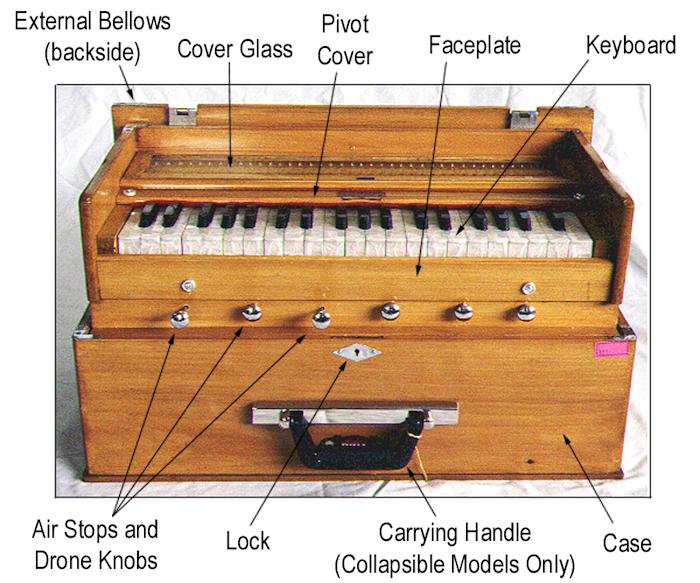
When playing the instrument, the most important elements are the air stop knobs and the keys as described earlier. The important thing, though, is determining which knob does what.
The air stop knobs are connected inside the instrument to small blocks of wood that open holes between the inner bellows and the reed chamber when pulled out. An instrument may have anywhere from two to four air stop knobs. (A few models have no knobs at all, in which case the air holes are always open.)
For Bina harmoniums, like the one shown here, the first and third knobs from the left are typically air stops for the male (higher register) and bass (lower register) reed sets, respectively. The second knob on this model opens another air stop for the bass register. For most players, it’s sufficient to open one male and one bass air stop.
In the diagram above, the fifth knob from the left (or second from the right) is what’s called the tremolo, a special air stop that works only when all others are pushed in. The tremolo is a simple mechanism that purposely causes brief interruptions in the air flow, thereby creating a kind of pulsing, warbling sound. (To get a sense of how it works, try talking normally while batting your mouth with an open hand.) The tremolo may be used in some musical styles, but usually not with devotional chanting.
The remaining knobs (the fourth and sixth in the picture) activate special drones notes, typically one of the black keys on the keyboard. When a drone knob is pulled out, the drone vibrates on its own so long as there’s pressure within the instrument. An instrument may have zero to five individual drones, which can be used in any combination.
The Harmonium Handbook contains an appendix that illustrates what the different knobs do on a variety of Bina models.
The octave coupler
Some harmoniums are equipped with a lever (or a knob) that couples each key to another that’s an octave above or below.
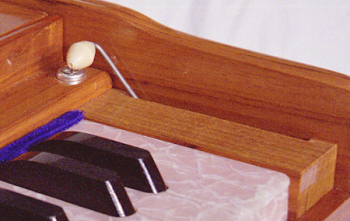
Using the coupler is an easy way to produce a fuller sound from the instrument because you double the number of reeds involved whenever you press a key. Allowing air past more reeds, however, increases the demands on the internal air pressure, requiring more vigorous pumping.
A peek inside
The surefire way to learn what each knob does for any model from any manufacturer is to open the instrument and take a look inside. On the instrument shown earlier, this process requires removing the faceplate by removing the two screws holding it to the keyboard base. You then remove the cover glass and locate two screws that hold the keyboard base down. Remove these screws and the keyboard lifts up on hinges located behind the faceplate. (The Harmonium Handbook contains instructions on disassembly and reassembly.)
Here’s what you’ll see inside, looking lengthwise across the instrument with the front to the right and the external bellows to the left.
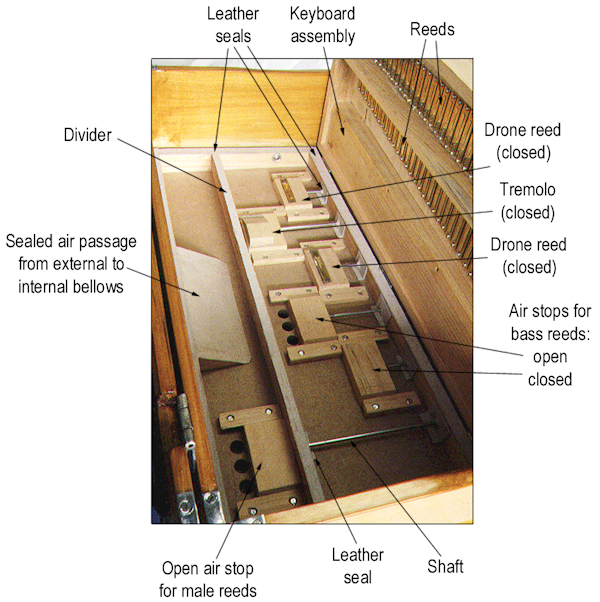
The reeds themselves are simply brass tongues connected at one end to a brass frame. In this following picture you can see several reeds, with one pushed into its frame to show the flexibility of the loose end.
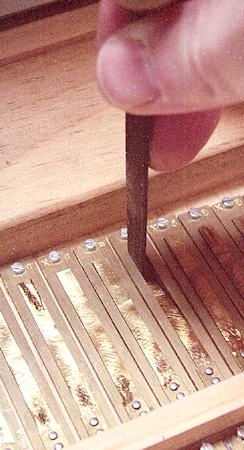
For more information
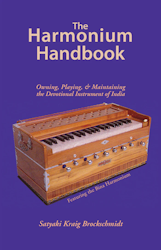
For more complete details on the design of the harmonium as well as instructions on many aspects of the instrument, refer again to The Harmonium Handbook, available from Crystal Clarity Publishers.
